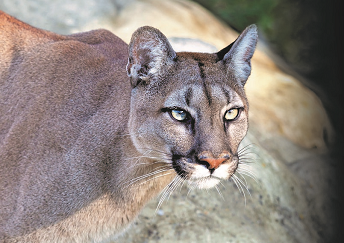
Mountain lions (Puma concolor couguar), also known as puma, cougar or panther, are native to California and the second largest felid in North and South America. They have the largest range of any carnivore in North America, ranging from the Canadian Yukon to southern Chile. They inhabit diverse habitat types throughout the state, including forests and foothills, coastal, rural, and wildlife-urban interfaces. They are reclusive and solitary animals, mostly avoiding people when possible.
Mountain lions provide many ecosystem benefits by helping to maintain healthy prey populations. They will hunt deer and elk, invasive species such as wild pigs and feral horses, and smaller animals such as coyotes, raccoons, and rodents. Potential conflict with mountain lions may occur due to property damage and loss of livestock or pets while hunting. Feeding other wildlife, such as deer, may attract mountain lions.